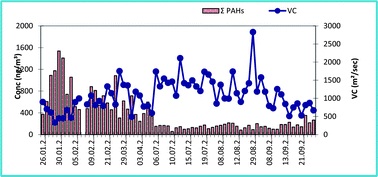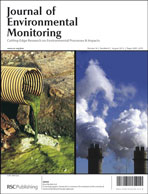Atmospheric polycyclic aromatic hydrocarbons in an industrialized city, Kocaeli, Turkey: study of seasonal variations, influence of meteorological parameters and health risk estimation
Abstract
Ambient gas and particle phase samples were collected during two sampling periods from a residential area of an industrialized city, Kocaeli, Turkey. The sampling occurred during winter months when structures were being heated, and summer months when structures were not being heated. Σ13PAH (gas + particle) concentrations ranged between 6.2 ng m−3 (DahA) and 98.6 ng m−3 (Phe) in the heating (winter) period and 3.0 ng m−3 (BaA) and 35.1 ng m−3 (Phe) in the non-heating (summer) period. Phe, Flt and Pyr were found to be at high concentrations in both sampling periods. Winter time to summer time concentration ratios for individual ambient PAH concentration ratios ranged between 1.2 (DahA) and 17.5 (Flu), indicating the effect of the emissions from residential heating on measured concentrations of PAHs, but great industrial plants and the only incinerator facility of Turkey are other important pollution sources around the city. Temperature dependence of gas phase PAHs was investigated using the Clausius–Clapeyron equation. A high slope obtained (5069.7) indicated the effect of the local sources on measured gas phase PAHs. Correlation of the supercooled vapor pressure (P0L) with the gas particle partitioning coefficient (Kp) and particle phase fraction was also evaluated. The relationship between the meteorological parameters and individual PAH (gas + particle) concentrations was investigated further by multiple linear regression analysis. It was found that the temperature had a significant effect on all of the measured PAH concentrations, while the effects of the wind speed and direction were not significant on the individual PAHs. On the other hand, PAH concentrations showed a strong linear relationship with the ventilation coefficient (VC) which showed the influence of local sources on measured PAHs. Benzo[a]pyrene toxic equivalent (BaPeq.) concentrations were used for health risk assessment purposes. The winter period risk level (2.92 × 10−3) due to the respiratory exposure to PAHs was found to be almost 3 times higher than in the summer period (1.15 × 10−3).


 Please wait while we load your content...
Please wait while we load your content...